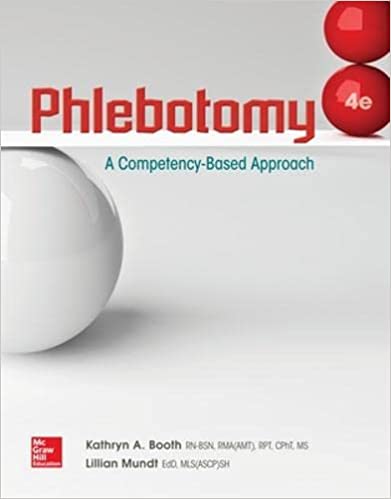Test Bank For Phlebotomy A Competency Based Approach 4Th Edition By Kathryn Booth
Digital item No Waiting Time Instant DownloadISBN-13: 978-0073513843 ISBN-10: 0073513849
In Stock
Original price was: $95.00.$40.00Current price is: $40.00.
Test Bank For Phlebotomy A Competency Based Approach 4Th Edition By Kathryn Booth
Chapter 02
Infection Controland Safety
Multiple Choice Questions
1. HAIs are infectionsA. of the nasal passage.B. that occur in communal settings.C. that are acquired from healthcare settings.D. with non-pathogenic organisms.
Healthcare-associated infections (HAIs) are infections that are acquired in a healthcare setting. They were once known as nosocomial infections.
ABHES: 3.d Define and use medical abbreviations when appropriate and acceptableAccessibility: Keyboard NavigationBlooms: RememberCAAHEP: III.C.3 Discuss infection control proceduresDifficulty: 1 EasyEst Time: 0-1 minuteLearning Outcome: 02.02NAACLS: 2.2.4 Define and discuss the term healthcare-acquired infection.Topic: Infection Control
2. A phlebotomist collects a specimen from a patient in an isolation room. What can the phlebotomist do to prevent the spread of infection?A. Wear all appropriate PPEs.B. Dispose of contaminated equipment outside the room.C. Wash his hands before removing his PPEs.D. Remove PPEs outside the room.
A phlebotomist must wear all required PPEs when entering a patient’s room. No contaminated material should leave the patient’s room.
ABHES: 4.f Comply with federal, state, and local health laws and regulations as they relate to healthcare settingsAccessibility: Keyboard NavigationBlooms: UnderstandCAAHEP: III.C.7 Match types and uses of personal protective equipment (PPE)Difficulty: 2 MediumEst Time: 0-1 minuteLearning Outcome: 02.02NAACLS: 2.2 Demonstrate accepted practices for infection control, isolation techniques, aseptic techniques and methods for disease prevention.Topic: Infection Control
Check All That Apply Questions
3. Which of the following bacteria have become resistant to antibiotics? (Choose all that apply)__X__ Clostridium difficile__X__ Enterococci__X__ Pseudomonas aeruginosa_____ Staphylococcus aureus
Some strains of Clostridium difficile, enterococci, Staphylococcus aureus, and Pseudomonas aeruginosa have become resistant to antibiotics.
ABHES: 3.b Build and dissect medical terms from roots/suffixes to understand the word element combinations that create medical terminologyAccessibility: Keyboard NavigationBlooms: RememberCAAHEP: III.C.5 List major types of infectious agentsDifficulty: 1 EasyEst Time: 0-1 minuteLearning Outcome: 02.01NAACLS: 2.2 Demonstrate accepted practices for infection control, isolation techniques, aseptic techniques and methods for disease prevention.Topic: Disease Transmission
Multiple Choice Questions
4. Which of the following bacteria have become resistant to vancomycin?A. Clostridium difficileB. EnterococciC. VaricellaD. Acinetobacter baumannii
Enterococci are bacteria that are found in the human intestine. Enterococci are resistant to vancomycin.
ABHES: 2.b Describe common diseases, symptoms and etiologies as they apply to each systemAccessibility: Keyboard NavigationBlooms: RememberCAAHEP: III.C.5 List major types of infectious agentsDifficulty: 1 EasyEst Time: 0-1 minuteLearning Outcome: 02.01NAACLS: 2.2 Demonstrate accepted practices for infection control, isolation techniques, aseptic techniques and methods for disease prevention.Topic: Disease Transmission
5. Which of the following bacteria have become resistant to ciprofloxacin and levofloxacin?A. Clostridium difficileB. Chlamydia trachomatisC. NeisseriaD. Fomite
C-diff can live outside the human body for an extended period of time. C-diff is also resistant to ciprofloxacin and levofloxacin.
ABHES: 2.b Describe common diseases, symptoms and etiologies as they apply to each systemAccessibility: Keyboard NavigationBlooms: RememberCAAHEP: III.C.5 List major types of infectious agentsDifficulty: 1 EasyEst Time: 0-1 minuteLearning Outcome: 02.01NAACLS: 2.2 Demonstrate accepted practices for infection control, isolation techniques, aseptic techniques and methods for disease prevention.Topic: Disease Transmission
6. What is an inanimate object capable of carrying a disease?A. FomiteB. Helicobacter pyloriC. Pseudomonas aeruginosaD. Giardia lamblia
A fomite is capable of transmitting infectious bacteria.
ABHES: 3.c Apply various medical terms for each specialtyAccessibility: Keyboard NavigationBlooms: RememberCAAHEP: III.C.1 Describe the infection cycle, including the infectious agent, reservoir, susceptible host, means of transmission, portals of entry, and portals of exitDifficulty: 1 EasyEst Time: 0-1 minuteLearning Outcome: 02.01NAACLS: 2.2.1 Identify and discuss the modes of transmission of infection and methods for prevention.Topic: Disease Transmission
7. For which of the following bacteria are some hospitals now screening patients upon admission?A. Clostridium difficileB. EnterococciC. Pseudomonas aeruginosaD. Staphylococcus aureus
Hospitals are now screening patients for MRSA, which is caused by Staphylococcus aureus.
ABHES: 2.b Describe common diseases, symptoms and etiologies as they apply to each systemAccessibility: Keyboard NavigationBlooms: RememberCAAHEP: III.C.1 Describe the infection cycle, including the infectious agent, reservoir, susceptible host, means of transmission, portals of entry, and portals of exitDifficulty: 1 EasyEst Time: 0-1 minuteLearning Outcome: 02.01NAACLS: 2.2.1 Identify and discuss the modes of transmission of infection and methods for prevention.Topic: Disease Transmission
8. Which government agency mandates the use of PPEs?A. CLSIB. HAZMATC. SDSD. OSHA
PPEs must be worn at all times. OSHA mandates which PPEs we must wear.
ABHES: 4.f Comply with federal, state, and local health laws and regulations as they relate to healthcare settingsAccessibility: Keyboard NavigationBlooms: RememberCAAHEP: III.C.7 Match types and uses of personal protective equipment (PPE)CAAHEP: XI.P.1 Comply with safety signs, symbols and labelsDifficulty: 1 EasyEst Time: 0-1 minuteLearning Outcome: 02.02NAACLS: 2.2.3 Discuss in detail and perform proper infection control techniques, such as hand hygiene, gowning, gloving, masking, and double-bagging.Topic: Infection Control
9. A medical laboratory technician (MLT) is about to prepare some chemical solutions. She suspects that there might be some health risks. Which quadrant of the NFPA label should she check for chemicals?A. BlueB. RedC. YellowD. White
The level of health risk of a chemical is shown in the blue quadrant of the NFPA label.


Reviews
There are no reviews yet.